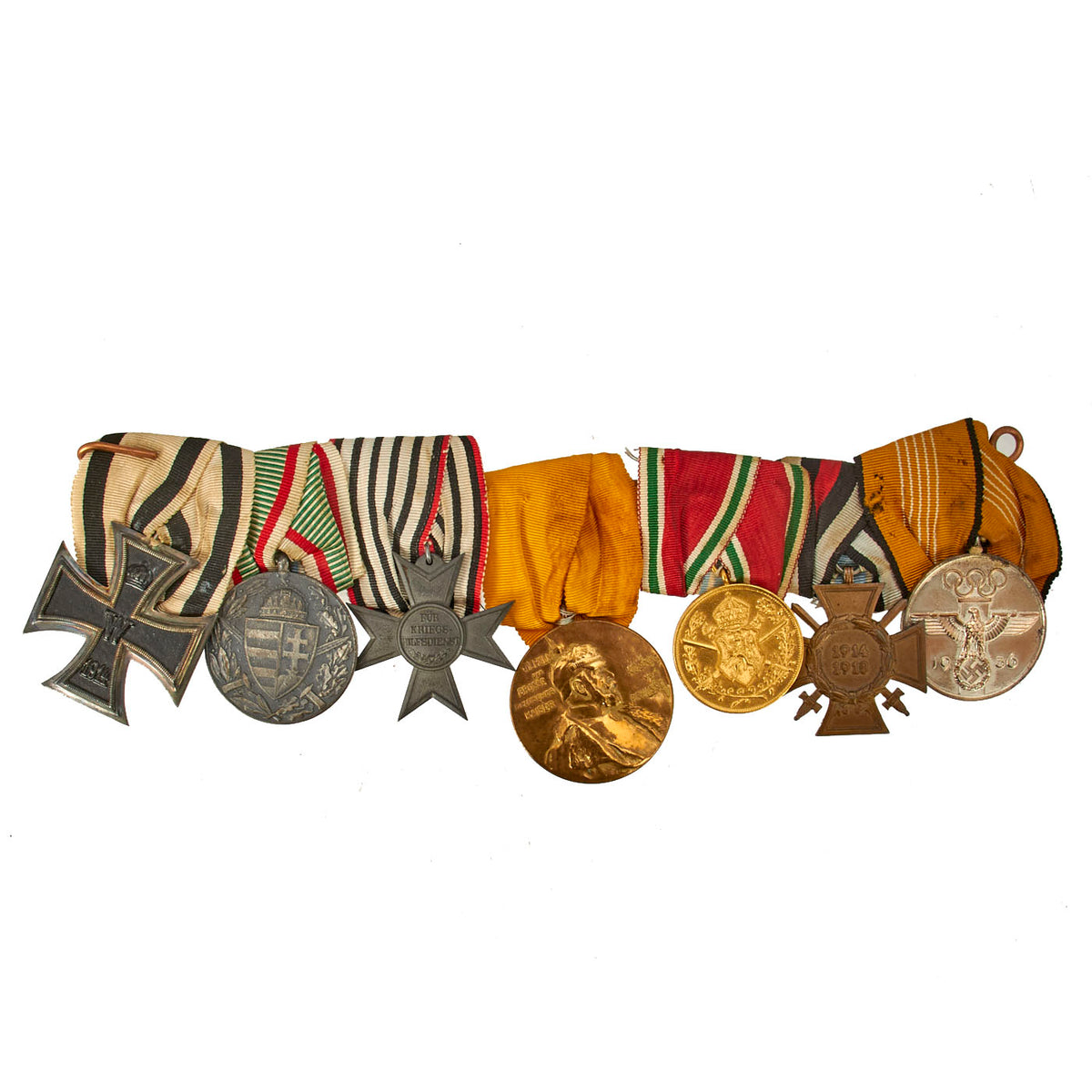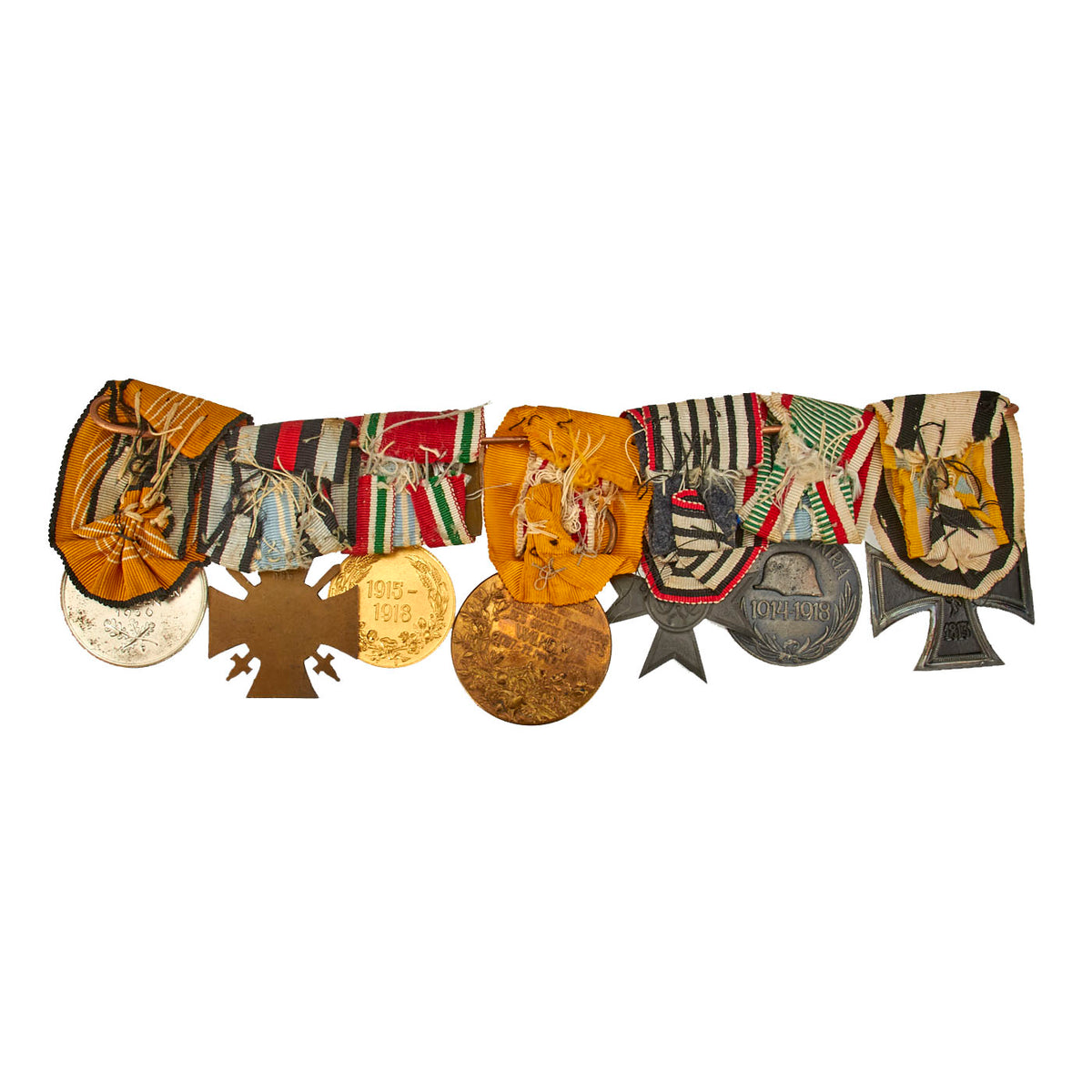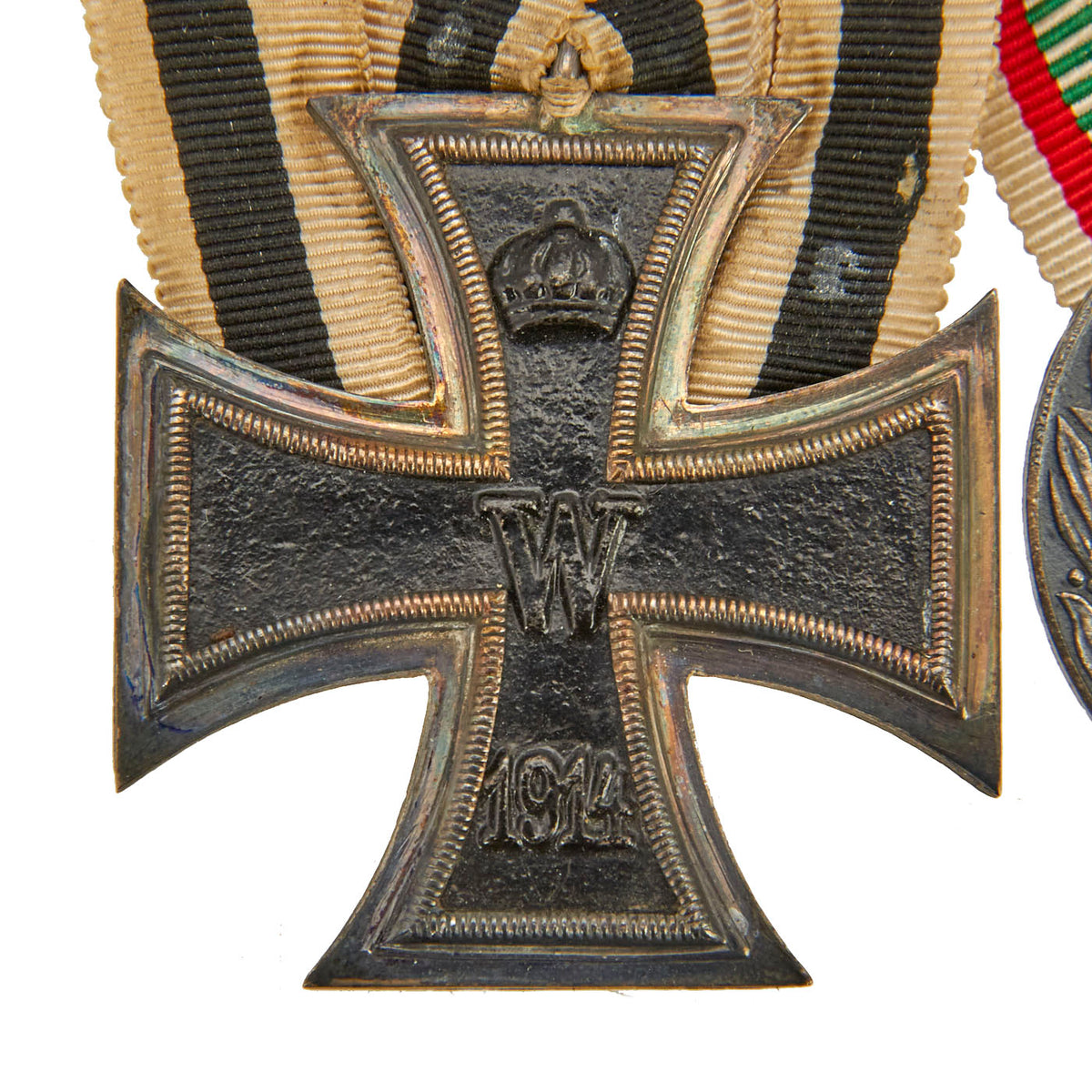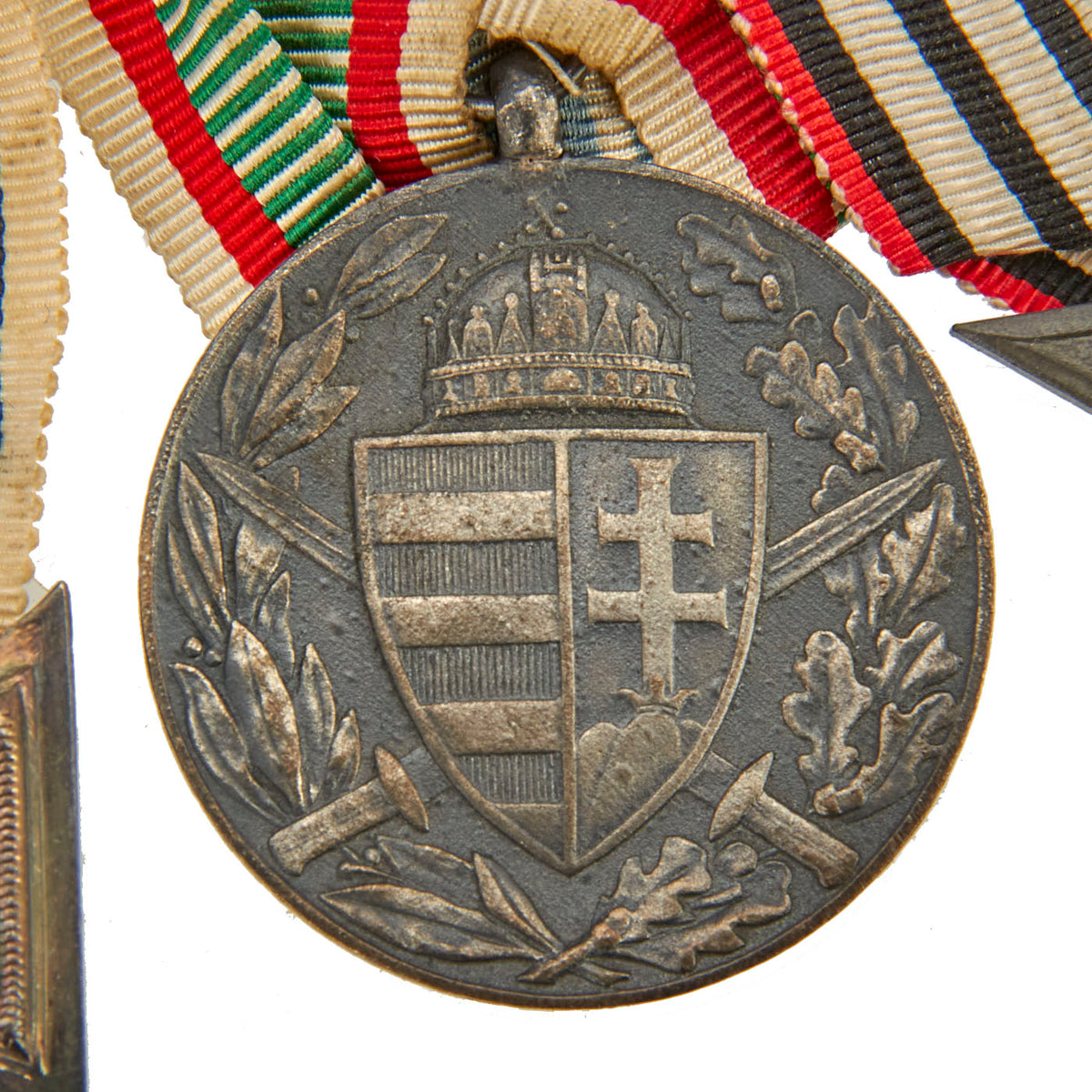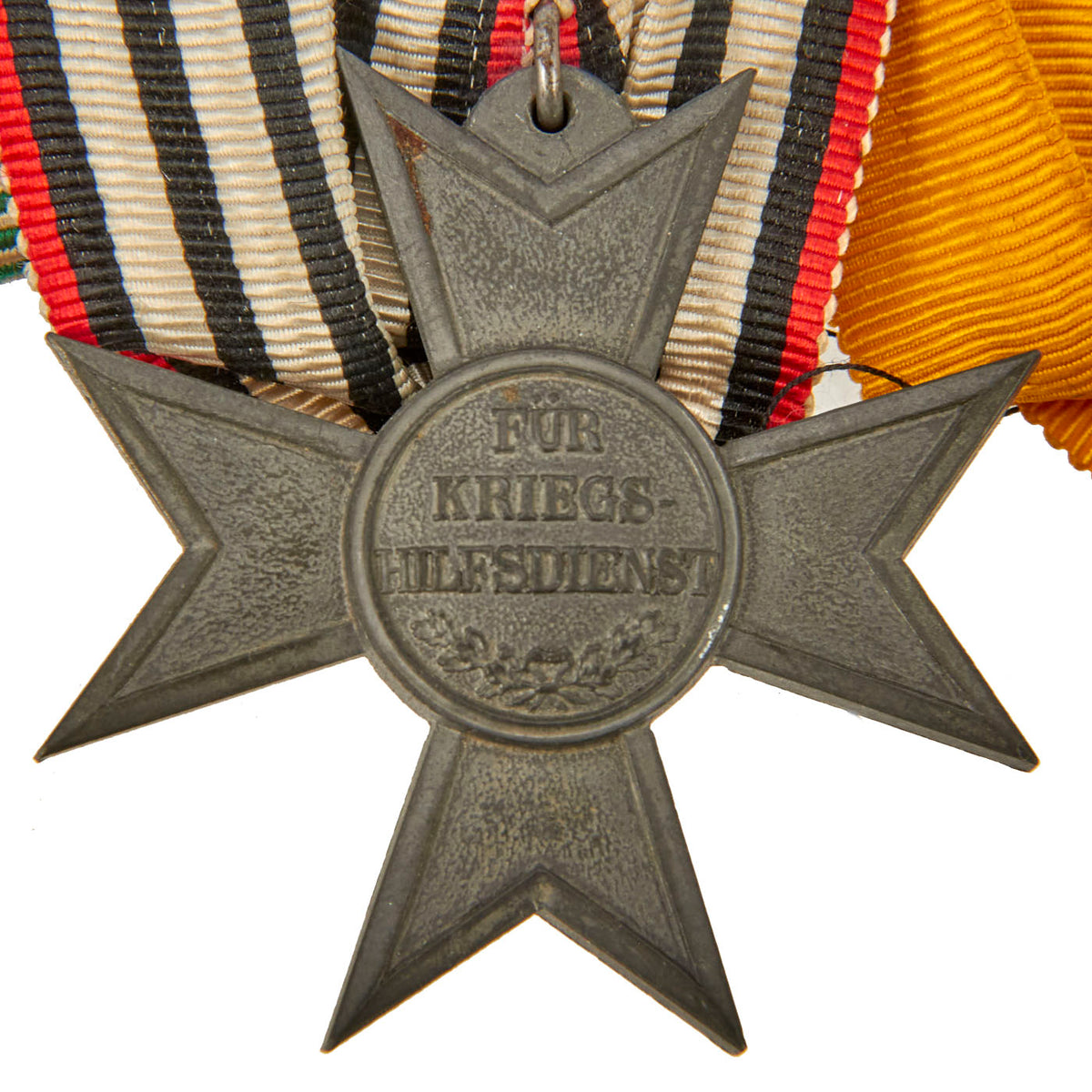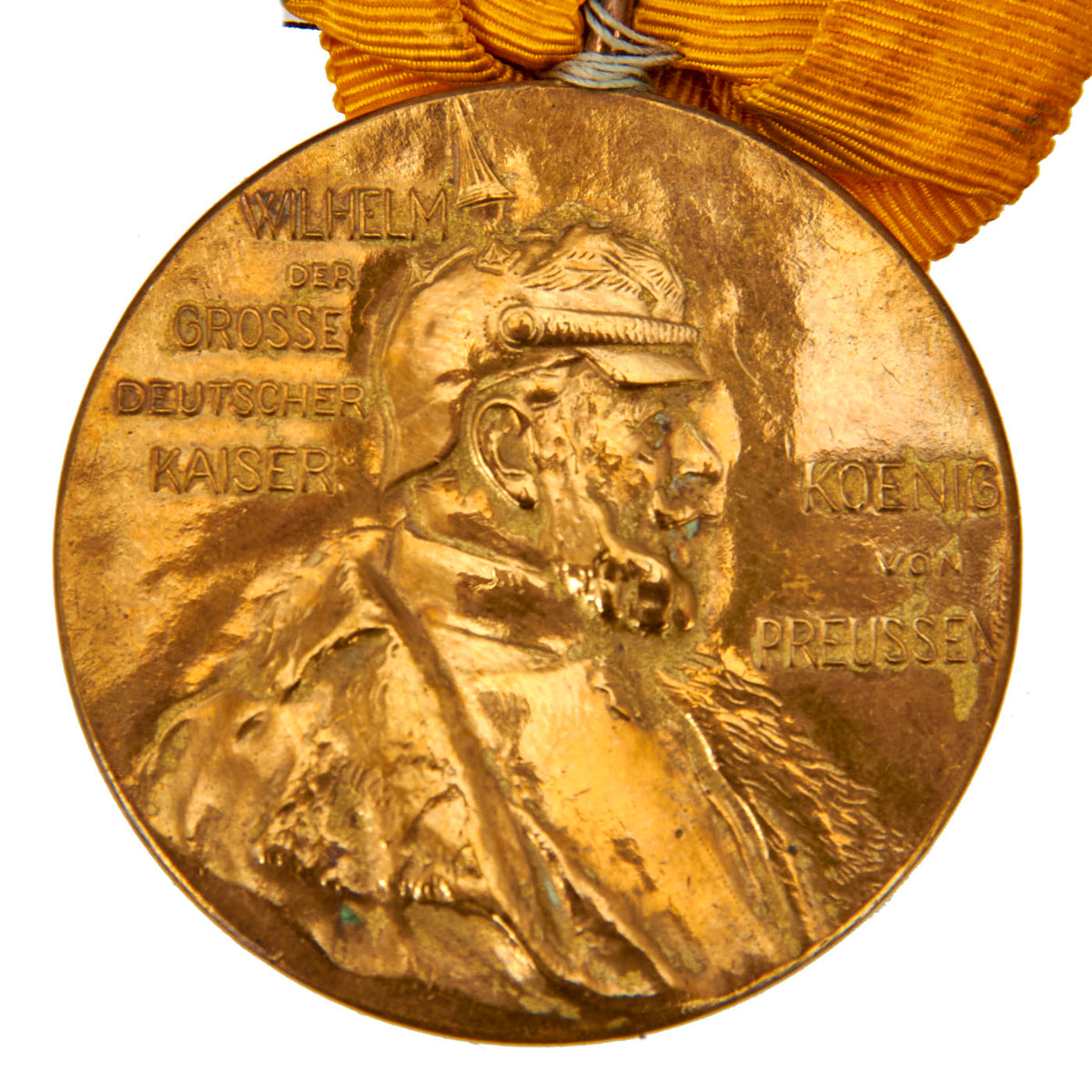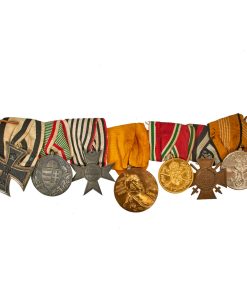Original German WWI & WWII Era Medal Set with EKII, Hindenberg Cross, 1936 Olympics Medal & More – 7 Awards Original Items
$ 595,00 $ 178,50
Original Item: One-of-a-kind. This is a very nice genuine medal set, which we assume was owned by a German soldier who fought during WWI, and then served in some fashion during the NSDAP period.
The set of 7 medals offered in good condition is mounted on a copper wire, which serves as a sort of ad hoc medal bar, but they are only fastened with stitching through the ribbons. This means that they can easily move back and forth. The colors are well retained, with some light staining and overall oxidation on the various awards.
It consists of the following medals with Ribbons:
– Imperial German WWI Iron Cross 1914 2nd Class Medal (Eisernes Kreuz 2. Klasse, or EKII)
– Austro-Hungarian WWI Pro Deo et Patria Military Medal 1914 1918 for Combatants
– Imperial German WWI Merit Cross for War Aid (Prussian)
– Imperial German Pre-WWI Kaiser Wilhelm Memorial Medal aka Centenary Medal 1897
– WWI Hungarian/Bulgarian European War Commemorative Medal
– German WWI Honor Cross of the World War 1914/1918 (Hindenburg Cross) Medal with Swords (For Combat)
– German Pre-WWII 1936 Olympic Commemorative Medal Decoration
Below is an explanation of each medal in detail:
German WWI Prussian Iron Cross 2nd Class with Ribbon:
Established by Frederick William in 1813 for gallantry in action, the Eisernes Kreuz (EK) decoration was revived several times for later conflicts. The bulk of the issues are divided into 1st and 2nd class versions, but a rare and superior ‘Grand Cross’ was also awarded for successful field commanders. During WW1 the lower decoration was freely awarded with 5½ million second class types issued. Originally, the Iron Cross was an award of the Kingdom of Prussia, however given Prussia’s pre-eminent place in the German Empire formed in 1871, it became an award for all of Germany.
The basic design of the WW1 crosses is a central cross patee struck from iron and mounted in a silver frame which has a raised crenulated decorative border. The obverse of the cross bears the date 1914 under a crowned ‘W’ monogram. Reverse bears an oak leaf cluster with the date of the decoration’s institution, 1813 underneath – the crowned initials of Frederick William are in the top arm above the oak leaf cluster. Suspension for second-class types is by means of a ring, and frequently this ring bears a maker’s stamp.
Please examine the edge seam for authentication, which is not present on reproductions. Iron crosses were commonly constructed from an iron core sandwiched in a surrounding two part silver frame, normally the seam of these two silver parts is visible around the edge of the cross as is seen on this fine example.
Austro-Hungarian WWI Pro Deo et Patria Military Medal 1914-1918:
Hungary (Austro-hungarian Empire): Hungarian WWI Commemorative Combatant’s military medal PRO DEO ET PATRIA (for God and Country). Award for the participation in the Great War. The medal was instituted in 1929. It is mounted on the correct red white and green ribbon, though the green has faded almost completely to yellow. It has the crossed swords on the ribbon, indicating it was awarded to a Combatant in the war.
The Merit Cross for War Aid (German: Verdienstkreuz für Kriegshilfe) was a war decoration of Prussia awarded during World War I. Instituted 5 December 1916, the cross was awarded for patriotic war aid service, without regard to status or rank. The award is in the shape of a Maltese cross, typically found made of blackened Kriegsmetall alloy. The obverse of the cross bears a circular central medallion with the crowned cipher of King Wilhelm II. On the reverse the central medallion is inscribed FÜR KRIEGS-HILFSDIENST (For War Aid Merit) above an oak wreath. To the upper arm is attached a loop for suspension from its ribbon.
Kaiser Wilhelm Memorial Medal
The Kaiser Wilhelm Memorial Medal, also known as the Centenary Medal (German: Kaiser-Wilhelm-Erinnerungsmedaille Zentenarmedaille) was established on March 22, 1897 by Wilhelm II on the occasion of the 100th Birthday of his grandfather, Emperor Wilhelm I.
The medal was awarded by Prussia to state and university officials, as well as all military officers, non-commissioned officers and enlisted personnel, which were actively serving in army, navy and Schutztruppe. Medals were also awarded to the surviving veterans of the First Schleswig War, Second Schleswig War, Austro-Prussian War, and the Franco-Prussian War. The medal is made of bronze gunmetal from captured cannon. It is 40 mm in diameter and was suspended from a ribbon 36 mm wide.
The obverse is a right facing effigy of Wilhelm I in military uniform wearing a mantle and Pickelhaube. To the left of the effigy is the inscription WILHELM / DER / GROSSE / DEUTSCHE / KAISER (William the Great German Emperor). To the right is KOENIG / VON / PREUSSEN (King of Prussia).
The reverse depicts symbols of royal authority including the German State Crown, an orb, sword, and scepter placed upon a pillow surrounded by oak leaves, in the lower half of the medal. To the left is an upward climbing laurel branch. In the upper half is the inscription in six lines ZUM ANDENKEN AN DEN HUNDERTSTEN GEBURTSTAG DES GROSSEN KAISERS WILHELM I. 1797 22.MAERZ 1897 (IN MEMORY OF THE HUNDREDTH BIRTHDAY THE GREAT EMPEROR WILHELM I. 1797–MARCH 22–1897).
Hungarian/Bulgarian European War Commemorative Medal:
The Bulgarian European War Commemorative Medal was instituted in 1933, and was available to all WWI veterans including military personnel, non-combatants like medical personnel and civilian officials and next-of-kin. Allied veterans were eligible. The ribbon on this example indicates it was awarded to a combatant. Non-combatant ribbons were the same except with a white stripe down the middle, and next-of-kin medal ribbons had a black mourning stripe in the center.
Hindenburg Cross with Crossed Swords (for combat):
The Honor Cross of the World War 1914/1918 (German: Das Ehrenkreuz des Weltkriegs 1914/1918), commonly, but incorrectly, known as the Hindenburg Cross was established by Field Marshal Paul von Hindenburg, President of the German Republic, by an order dated 13 July 1934, to commemorate the distinguished deeds of the German people during the First World War. This was Germany’s first official service medal for soldiers of Imperial Germany who had taken part in the war, and where they had since died it was also awarded to their surviving next-of-kin. Shortly after its issuance, the government of NSDAP Germany declared the award as the only official service decoration of the First World War and further forbid the continued wearing of German Free Corps awards on any military or paramilitary uniform of a state or NSDAP Party organization.
This example is marked on the back with L. / N.B.G., a known maker marking, which has not been identified.
The German Olympic Decoration (German: Deutsche Olympia-Ehrenzeichen or Deutsches Olympiaehrenzeichen) was a civil decoration of Germany awarded to administrators of the IV Olympic Winter Games in Garmisch-Partenkirchen and the Games of the XI Olympiad in Berlin 1936. The award was not intended for actual participants in the Olympic Games, but rather in recognition of those who had orchestrated the “behind the scenes” preparations and work for the events.
The German Olympic Decoration was awarded in three classes, the highest of which was a “Neck Order”:
- 1st Class
- 2nd Class
- German Olympic Commemorative Medal
The German Olympic Commemorative Medal (German: Deutsche Olympia-Erinnerungsmedaille) was established to recognize service in connection with the preparation work and execution of the game events. The medal was not restricted to German nationals.
Fast Shipping with Professional Packaging
Thanks to our longstanding association with UPS FedEx DHL, and other major international carriers, we are able to provide a range of shipping options. Our warehouse staff is expertly trained and will wrap your products according to our exact and precise specifications. Prior to shipping, your goods will be thoroughly examined and securely secured. We ship to thousands clients each day across multiple countries. This shows how we're dedicated to be the largest retailer on the internet. Warehouses and distribution centres can be located throughout Europe as well as the USA.
Note: Orders with more than one item will be assigned a processing date depending on the item.
Before shipping before shipping, we'll conduct a thorough inspection of the items you have ordered. Today, the majority of orders will be delivered within 48 hours. The delivery time will be between 3-7 days.
Returns
The stock is dynamic and we cannot completely manage it because multiple stakeholders are involved, including our factory and warehouse. So the actual stock may alter at any time. It's possible that you may not receive your order once the order has been made.
Our policy is valid for a period of 30 days. If you don't receive the product within 30 days, we are not able to issue a refund or an exchange.
You can only return an item if it is unused and in the same state as the day you received it. You must have the item in its original packaging.
Related products
Uncategorized
Uncategorized
Uncategorized
Uncategorized
Uncategorized
Uncategorized
Armoured Fighting Vehicles of the World: AFVs of World War One (Hardcover Book) New Made Items
Uncategorized
Band of Brothers ORIGINAL GERMAN WWII Le. F.H. 18 10.5cm ARTILLERY PIECE Original Items
Uncategorized
Uncategorized
Uncategorized
Uncategorized
Uncategorized
Uncategorized
Uncategorized
Uncategorized
Uncategorized
Australian WWII Owen MK1 Machine Carbine SMG Custom Fabricated Replica with Sling Original Items
Uncategorized
Uncategorized
